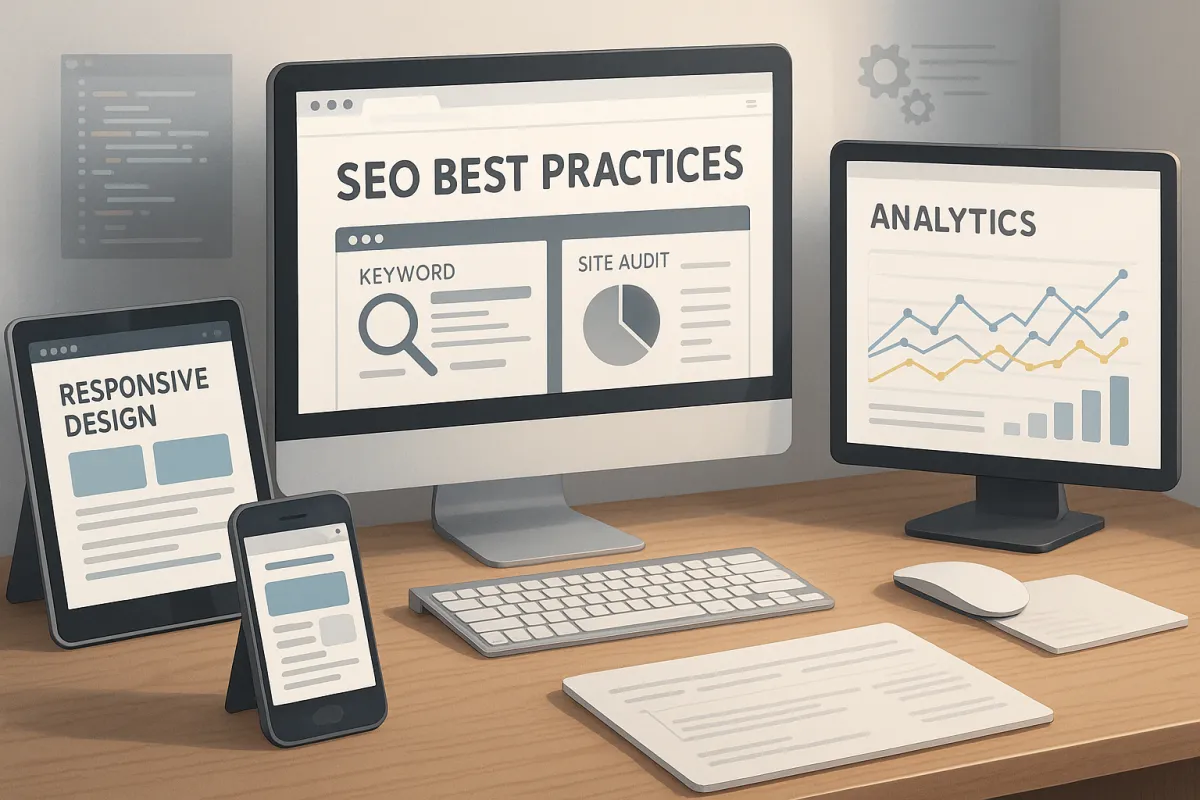
Optimize Your Site: SEO Best Practices for Web Design
SEO Best Practices for Web Design: Techniques to Optimize Website Performance and User Experience
Designing a beautiful website is only part of the equation—if your site isn’t optimized for search engines, it won’t reach its full potential. SEO-focused web design blends visual appeal with technical performance, ensuring your site is not only engaging but discoverable. In this guide, we’ll break down SEO best practices that modern web developers, digital marketing agencies, and businesses should integrate into every design phase to improve visibility, user experience, and long-term success.
What Are the Essential SEO Web Design Techniques for Better Search Rankings?
Clean and crawlable code that aids search engine indexing
Responsive and mobile-first layout for user experience design
Optimized images and fast loading times to reduce bounce rate
Clear site architecture and SEO-friendly URL structure
Integrated keyword research in content, web page layout, and metadata
How Does Responsive Design Improve SEO and User Engagement?
Responsive web design ensures your site adapts to any screen size, reducing bounce rates and boosting dwell time. Google prioritizes mobile-friendly sites in organic search results, making responsiveness essential for both SEO and customer satisfaction.
Why Is Mobile-Friendly Web Design Critical for SEO Success?
With over half of web traffic coming from mobile devices, mobile-friendliness directly impacts:
Core Web Vitals performance
Bounce rate and user engagement
Visibility in mobile search engine results
What on-Page SEO Elements Should Be Integrated During Web Design?
Title tags and meta descriptions optimized for your target audience
Heading hierarchy (H1, H2, H3) for structure and readability
SEO-friendly URLs with focus keywords
Schema markup to improve visibility in search engine algorithms
How Can Website Speed Optimization Enhance SEO and User Experience?
Page speed is a confirmed Google ranking factor. Faster websites:
Provide better customer experience and usability
Reduce abandonment and bounce rates
Improve Core Web Vitals scores and ROI
What Are the Best Practices to Improve Website Loading Times?
Compress images and use WebP or next-gen formats
Minimize CSS and JavaScript files
Use lazy loading for media elements
Leverage caching and a content delivery network (CDN)
How Does Website Speed Affect Core Web Vitals and SEO Rankings?
Core Web Vitals (LCP, FID, CLS) measure loading, interactivity, and visual stability. These metrics influence:
Page experience scores in search engine rankings
Overall site credibility, reputation, and user interface
How to Implement on-Page SEO for Web Design Effectively?
Start with a solid sitemap and keyword strategy. Then:
Structure web pages with keyword-rich headers
Use internal linking between content management system pages
Optimize images with descriptive file names and alt tags
What Role Do Keywords Play in Web Page Structure and Content?
Keywords influence:
Page titles, meta descriptions, and anchor text
Header tags and body copy for SEO alignment
Internal linking and content architecture
Balanced keyword placement boosts visibility without sacrificing content quality.
How to Optimize Meta Tags, Headings, and URLs for SEO?
Meta titles: Incorporate primary keywords within 60 characters
Meta descriptions: Compel clicks with strong CTAs in 155 characters
Headings: Follow a clear and logical structure
URLs: Keep short, readable, and keyword-optimized
Why Is Internal Linking Important in SEO-Focused Web Design?
Internal linking helps:
Search engines discover and index web pages
Users navigate site content seamlessly
Distribute link equity and improve topical relevance
What Are the Best Practices for Creating a Mobile-Friendly Web Design?
Use responsive grids and scalable graphic design elements
Optimize for vertical scrolling
Minimize intrusive popups and use mobile-friendly tap targets
Test for usability across devices using tools like Google’s Mobile-Friendly Test
How to Ensure Responsive Layouts Work Across All Devices?
Use CSS media queries and flexible components
Test on Android, iOS, tablets, and desktops
Design using live previews within your CMS dashboard
What UX Factors Improve Mobile SEO Performance?
Fast loading speeds
Clean, thumb-friendly navigation
Clear call-to-actions and form fills
Consistent branding and layout
How to Test and Validate Mobile-Friendliness for SEO?
Google’s Mobile-Friendly Test and PageSpeed Insights
Lighthouse audits and Core Web Vitals monitoring
Responsive testing within platforms like WordPress CMS
How Does User Experience (UX) Influence SEO in Web Design?
UX metrics such as time on site, pages per session, and bounce rate act as engagement signals. Intuitive navigation, quality content, and clean interface design keep users on-site longer and build brand confidence.
What UX Design Elements Boost Visitor Engagement and SEO?
Strong hero sections with value-driven headlines
Clear and organized navigation
Visual hierarchy, whitespace, and typography
Aligned CTAs based on search intent
How to Balance Visual Appeal With SEO Requirements?
Use accessible, clean web design that avoids clutter
Minimize resource-heavy animations
Maintain a semantic HTML structure for bots and usability
Why Is Data-Driven Optimization Key to Continuous SEO Improvement?
Monitoring site analytics and feedback allows you to:
Adapt based on real-time user behavior
Improve performance post-launch
Identify opportunities to increase ROI
What Are the Latest Trends and Tools in SEO-Focused Web Design?
AI-powered tools like Surfer SEO, Jasper, and Frase
Schema-rich snippets and structured data
Dynamic web content tailored to searcher behavior
UX testing tools like Hotjar for visual feedback
How Is AI Changing SEO and Web Design Integration?
AI enables:
Automated keyword clustering and content ideation
Predictive UX personalization
Smart image alt tagging and SEO audits
What Role Does Voice Search Optimization Play in Web Design?
Voice search is growing with smart devices. Optimize with:
Natural, conversational language
FAQ sections and featured snippets
Local SEO enhancements for mobile users
How to Optimize Images and Visual Content for SEO?
Use descriptive file names and alt tags
Resize for performance without compromising quality
Use captions to support relevance
How to Maintain and Monitor SEO Performance After Web Design Launch?
Use Google Analytics, Search Console, and other tracking tools
Set up keyword tracking and backlink monitors
Perform monthly audits to check performance and data trends
What Are the Best Practices for SEO Reporting and Analytics?
Build custom dashboards tracking KPIs
Set conversion goals in GA4
Share actionable feedback with clients or stakeholders
How to Update Content and Technical SEO for Long-Term Success?
Regularly refresh blog posts and landing pages
Reoptimize with updated keywords and media
Fix broken links, outdated metadata, and slow-loading assets
Why Is Regular SEO Auditing Important for Website Health?
Catch technical issues before rankings drop
Ensure ongoing compliance with algorithm updates
Align evolving content strategy with user needs and industry changes
SEO should be part of every custom website design, from the first brainstorm to post-launch optimization. Whether you're working with a web design company, local web developers, or a digital marketing agency, integrating SEO best practices ensures your site attracts traffic, builds brand awareness, and delivers measurable returns.
